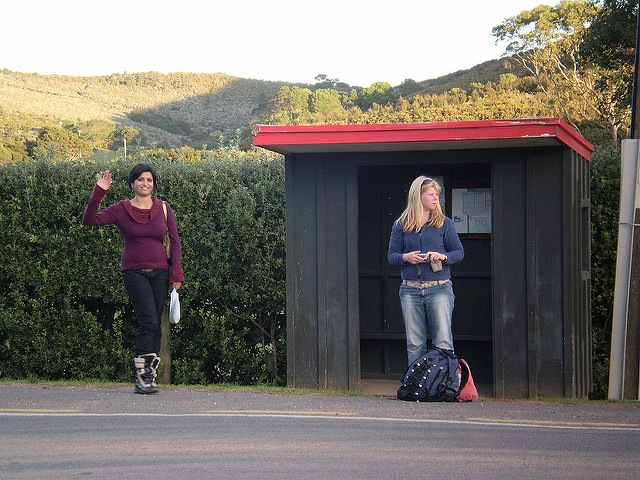Unlock the Magic in Your Story Now
Get the Free 20 questions to Ask Before Launching Your Idea workbook when you sign up for occasional updates.
Get the Free 20 questions to Ask Before Launching Your Idea workbook when you sign up for occasional updates.
Articles filed in: Strategy
Victims Of Success
 We’ve all been let down by a business we were loyal to or disappointed by a product we once loved. When we dissect what happened, it’s often possible to trace the missteps to a single source. Thriving businesses become victims of their success, and great products become mediocre when the people who built them forget how they got from there to here.
We’ve all been let down by a business we were loyal to or disappointed by a product we once loved. When we dissect what happened, it’s often possible to trace the missteps to a single source. Thriving businesses become victims of their success, and great products become mediocre when the people who built them forget how they got from there to here.
No matter how successful you become, the often intangible qualities that differentiated you in the beginning, will continue to be what keeps customers coming back.
Image by pkhamre
The Forgotten Power Of The Single Interaction
 On a recent trip to Waiheke Island with my husband, we stopped a bus that wasn’t going our way. The driver told us to hop on anyway, and he’d take us to where we could catch a bus that would get us to where we wanted to go. Then, wait for it—he radioed ahead to the driver of that bus to let her know he had a couple of passengers on board who needed to catch her bus. She was waiting for us at the depot when we got there.
On a recent trip to Waiheke Island with my husband, we stopped a bus that wasn’t going our way. The driver told us to hop on anyway, and he’d take us to where we could catch a bus that would get us to where we wanted to go. Then, wait for it—he radioed ahead to the driver of that bus to let her know he had a couple of passengers on board who needed to catch her bus. She was waiting for us at the depot when we got there.
The driver of the wrong bus could simply have done his job. He could have told us to wait for the next bus that was due in twenty minutes. He could have decided that in the scheme of things this one interaction was insignificant. He chose to think otherwise.
In our globalised, digital world, as we try to hustle our way to making a bigger impact, it’s easy to forget that change doesn’t have to happen at scale. Just as a single well-placed domino in a domino run can knock all the dominos down one-by-one, we each have the power to change a day or a life in a single interaction. We don’t have to reach everyone all at once.
Image by Nina
From Average To Exceptional
 The menu at Fumi’s restaurant is identical to every other sushi restaurant in town. The ingredients come from the same fish market, and the prices are similar. On the face of it, there’s nothing to set the restaurants apart and no reason for a diner to favour one over another. The difference is only apparent after you’ve eaten at Fumi’s place. It isn’t just what the chefs cook that creates a line out the door every lunchtime. It’s how it’s made and the way it’s served that changes everything.
The menu at Fumi’s restaurant is identical to every other sushi restaurant in town. The ingredients come from the same fish market, and the prices are similar. On the face of it, there’s nothing to set the restaurants apart and no reason for a diner to favour one over another. The difference is only apparent after you’ve eaten at Fumi’s place. It isn’t just what the chefs cook that creates a line out the door every lunchtime. It’s how it’s made and the way it’s served that changes everything.
It’s hard to put your finger on what makes an experience memorable, but that doesn’t stop us and marketers the world over trying to do it because we want to recreate that kind of magic for our clients and customers.
What takes something from average to exceptional is surprisingly simple and consistently hard to do. The attitude of everyone who touches the product and creates the experience is what matters most in the end. When the people who make, serve and sell things believe and act as if it’s a privilege to do the work, they can’t help but create better experiences.
We do work that matters by believing that it matters.
Image by Jeena Paradies
Who Exactly Is It For?
 Alec has been on the road since 4 am. He’s picked up three fares all morning. The arrival of Uber has hit him and other Melbourne taxi drivers hard. According to Alec, the taxi industry has seen a 40% decline. He says he earned as much twenty years ago as he does today. He complains bitterly about the regulators and his bosses—now in his fifties, he reckons he’s too old to switch jobs.
Alec has been on the road since 4 am. He’s picked up three fares all morning. The arrival of Uber has hit him and other Melbourne taxi drivers hard. According to Alec, the taxi industry has seen a 40% decline. He says he earned as much twenty years ago as he does today. He complains bitterly about the regulators and his bosses—now in his fifties, he reckons he’s too old to switch jobs.
Joey hasn’t been driving as long as Alec. But he understands why many riders prefer the convenience of Uber. He knew as soon as the ride-hailing app arrived in Australia there was no way he could compete on speed or price. So he made a conscious decision not to try being faster or cheaper than Uber, but to find and serve a group of riders he could delight instead. Joey operates a small airport transfer car service. He charges the same rate as a taxi but provides a more personal, upmarket service with the intention of attracting repeat business clients. Joey’s strategy is working. He doesn’t have to drive the city streets finding customers for his service because he’s intentionally designed a service for his customers.
The more deliberate and specific we are about who we want to serve, the better our products and services will be.
Image by Matthias Ripp
Becoming The Obvious Choice
 Today you will repeatedly engage in the process of persuasion. You will try to engage with someone in a way that convinces them to change their opinions, choices or actions—their mind or their behaviour. You will aim to persuade them that you or your product are the obvious choice.
Today you will repeatedly engage in the process of persuasion. You will try to engage with someone in a way that convinces them to change their opinions, choices or actions—their mind or their behaviour. You will aim to persuade them that you or your product are the obvious choice.
We tend to think that persuasion is simply about laying out well-reasoned arguments that help the best or most obvious choice bubble to the surface. But ‘best’ is subjective and variable because it’s dependent upon the circumstances surrounding the moment when people are invited to change or choose.
The work of psychologists like Robert Cialdini into the science of persuasion demonstrates that it’s not just what we say that counts, it’s also how and when we say it that matters. A hotel can get more guests to reuse towels by subtly changing the script on the sign in the bathroom. A waiter can increase his tips by offering mints along with the bill.
Becoming the obvious choice isn’t only about clearly laying out benefits to the prospective customer. It’s about understanding the context in which the decision is being made.
Eliciting a choice or change isn’t only or always about making it more obvious.
Image by bassnroll
The Downside Of Competing For Customers
 The boardroom was ready. We each had a bottle of French sparkling water, a notebook and pen next to our seat. Delicious herbal tea and snacks were served on our arrival. We were meeting to discuss how best to tell a story that resonated with the client’s customers before the launch of a new marketing campaign next season. The marketing team’s carefully prepared presentation was locked and loaded, and examples of their past promotions had been laid out down the middle of the long boardroom table, alongside those of their competitors.
The boardroom was ready. We each had a bottle of French sparkling water, a notebook and pen next to our seat. Delicious herbal tea and snacks were served on our arrival. We were meeting to discuss how best to tell a story that resonated with the client’s customers before the launch of a new marketing campaign next season. The marketing team’s carefully prepared presentation was locked and loaded, and examples of their past promotions had been laid out down the middle of the long boardroom table, alongside those of their competitors.
The team presented data about the previous campaign’s performance relative the competition. They knew exactly what their competitors’ strategy had been and how much revenue each company had generated. They compared the different strategies in great detail. They outlined the targets they wanted to hit. But not once throughout the entire presentation did they question what their customer wanted. The customer barely got a mention. This company is not alone in neglecting to make room for customers at the table.
In our race to compete for a slice of the market, we have become fearfully reactive to the marketplace, instead of being bravely responsive to the people we intended to serve. We may have forgotten our customers, but it’s not too late to fix this. We can’t begin to be something to our customers without first understanding who we are and who we intend to become.
Image by freeimage4life
Everything Starts With Something
 When we’re starting a project or working towards a business development goal we typically have a laundry list of everything we want to do. From developing a new product to filing our tax returns, it’s in our nature to want to make immediate and visible progress all at once. That desire to do everything often results in paralysis. Everything seems overwhelming. Everything is daunting. Everything is impossible. So we end up doing nothing.
When we’re starting a project or working towards a business development goal we typically have a laundry list of everything we want to do. From developing a new product to filing our tax returns, it’s in our nature to want to make immediate and visible progress all at once. That desire to do everything often results in paralysis. Everything seems overwhelming. Everything is daunting. Everything is impossible. So we end up doing nothing.
When we’re in a state of indecision or overwhelm about the next step to take there’s a magic question we can ask ourselves to clarify our options and create momentum.
‘If you could do anything, what would that be?’
The simplicity of some of the things on your ‘anything’ list will surprise you. Suddenly everything you could do becomes the things you should do. From there the trick is to pick one thing you will do. Everything starts with something. But only if you begin.
Image by Simon Q
The Empathy Profession
filed in Marketing, Storytelling, Strategy
 When I was growing up (and maybe when you were too), careers like medicine, nursing and teaching, were regarded as being part of the ’empathy profession’.
When I was growing up (and maybe when you were too), careers like medicine, nursing and teaching, were regarded as being part of the ’empathy profession’.
Today, every one of us, from accountants to designers, CEOs to Astronauts, are in the ’empathy profession’. No business or brand can thrive without understanding what it is their customer wants. No leader can create meaningful change without seeing the world through the eyes of her colleagues. No innovator can create relevant solutions unless he understands the challenge his invention helps someone to overcome.
It’s hard to empathise with someone unless you know their story. That’s why the software that gets used and the cafes that stay open were created by people who started with their customer’s story.
Whether you’re a designer at Google or a chocolate maker at Pana—it’s only possible to make things that people want by figuring out how those people want to feel in the presence of your product. You tell better stories by understanding the story the customer wants to tell herself. Caring is part of every job description now.
Download and use this Empathy Map PDF to help you get started.
Image by Hernán Piñera
A World Built On Promises
 Scott and Joanna are planning to open a two-hundred-seater restaurant along a small shopping strip that backs onto a residential area in their local suburb. They know the neighbours will be concerned about the prospect of increased traffic and noise from the venue, especially at the weekend when they open until 1 am. So they draw up a plan to mitigate the negative impact their business might have on the people who live in the area. They commit on paper to limiting the number of patrons allowed in the rooftop bar and to monitoring late-night noise levels. The trouble with the plan is that the restauranteurs’ intentions are at odds with the commercial reality of running a viable business. Their success depends on having a restaurant and bar full of happy customers spending money late into the evening. They will find it almost impossible to make the business profitable while simultaneously keeping the neighbours happy. Their goals are at odds with each other.
Scott and Joanna are planning to open a two-hundred-seater restaurant along a small shopping strip that backs onto a residential area in their local suburb. They know the neighbours will be concerned about the prospect of increased traffic and noise from the venue, especially at the weekend when they open until 1 am. So they draw up a plan to mitigate the negative impact their business might have on the people who live in the area. They commit on paper to limiting the number of patrons allowed in the rooftop bar and to monitoring late-night noise levels. The trouble with the plan is that the restauranteurs’ intentions are at odds with the commercial reality of running a viable business. Their success depends on having a restaurant and bar full of happy customers spending money late into the evening. They will find it almost impossible to make the business profitable while simultaneously keeping the neighbours happy. Their goals are at odds with each other.
We sometimes make promises we know in our hearts won’t be easy to keep. There will inevitably be times when we must balance good intentions with commercial imperatives. But saying one thing then doing another is the surest way to erode, not only the trust of others but our sense of integrity. The alternative is to make more honest promises, to focus on why we’re committed to keeping that promise and how exactly we’re going to do it, rather than just simply on what’s being promised.
We live in a world built on promises.
The people who keep them are the ones who win in every sense of the word.
Image by Elisa Dudnikova
Who Trusts You?
 We spend a lot of time wondering who we can trust. We are careful to work out who is worthy of our friendship, business or time. And yet, we often fail to make the connection between trust and success when it comes to ourselves.
We spend a lot of time wondering who we can trust. We are careful to work out who is worthy of our friendship, business or time. And yet, we often fail to make the connection between trust and success when it comes to ourselves.
You don’t become trusted by being more successful.
You become successful by being more trusted.
Start there.
Image by Zi Krostag